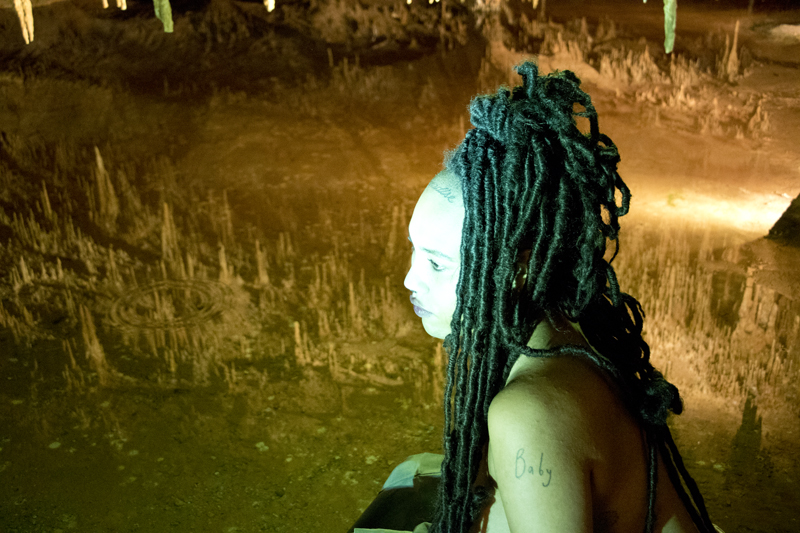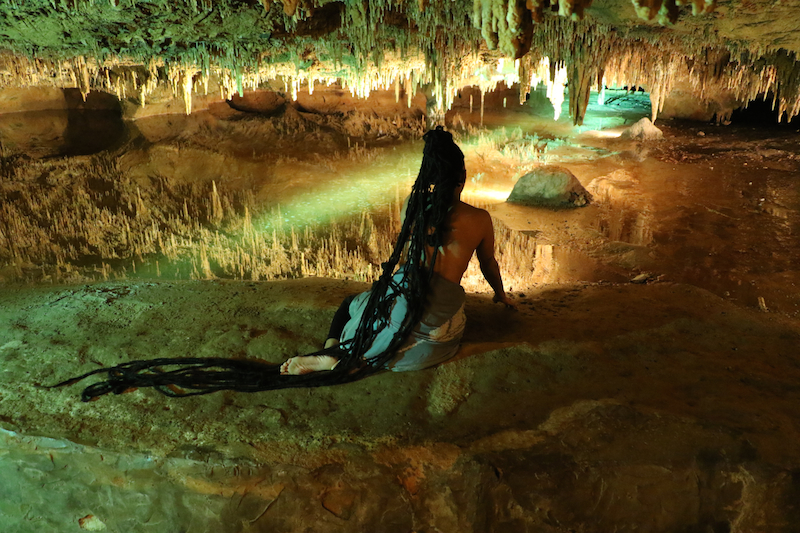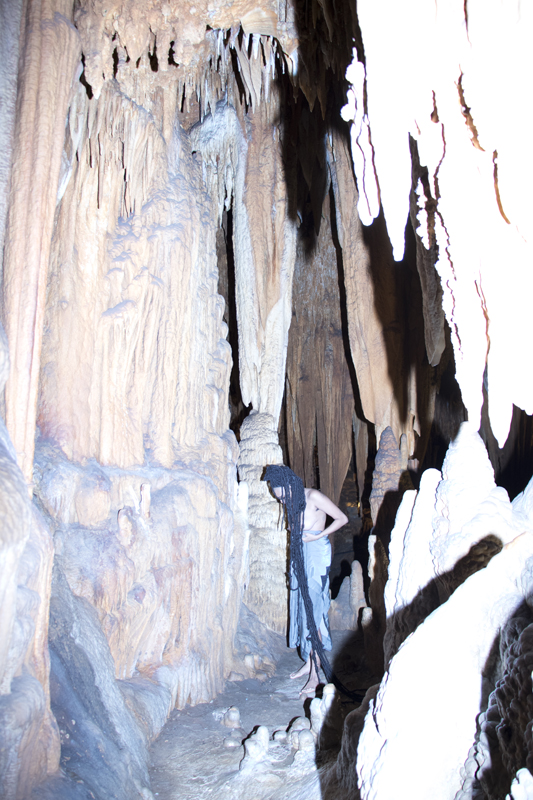Hayley Silverman’s SOUP
Hayley Silverman, A CUSP, A THORN, A BRISTLE, EVEN A (FAINT) POINT, 2015, from the Rapunzel series, photographic study for laser transfer [courtesy of the artist]
Share:
New York-based artist Hayley Silverman works in photography, performance, video, theater, sculpture, and printmaking. Common to the diverse media she works with is a form of scripted, self-enclosed, and even anti-participatory environments; a focus on the divisions between animal, human and machine; and a neo-modernist insight that links technology with primitivism, often through the theme and question of animism. Silverman asks the spectator to observe this nearly self-enclosed world with its rules and agents, which leaves him/her a particular, though often pleasurable, sense of remove, witness, or helplessness, as in her ongoing series of animal plays. For these, Silverman uses human actors to make audio-recordings of film screenplays (from 1930s Depression-era cinema, to Waking Life, The Cruise, or Lucy). Silverman may then attach speaker equipment to animals such as dogs or pigeons, cast to “perform” portions of the resulting script in a stage environment, or alternately to create sound durational works that give the illusion of the same. Silverman’s video Pre-Sensation (2010) was recorded in an empty, darkly lit ceramics shop; in it, a laser pointer animatedly dances to sound by her band Willendorf, around the contours of primitivist sculptures. Her recent soup-bowl replicas contain artificial ingredients such as model objects and toy humans, while in her Rapunzel series, women, some with long rope-like braids, occupy dreamy, sludgy caves.
Act I
Suppose we were the half-inch ones (the halflings), bubbles, pinkish knuckles on a blue vine. Or, when approached underside, towards the belly, we could be many strings (violas, flesh, yarn), gnawing termites under brush, obsidian, rosy barnacles that crown an obsolete evening’s tongue. All round things avoid commitment – commitment to the ballast and rebar in vowels, which makes things hard to say. Lights bloom with fatalism and inertia, red, headless, and agentless, on our planet that knows a rosary of suns. Swelling, she says, facing nothing, the laughter tumbling, the only play I am is me – a pigeon or a dog, a sneer of turnips or a carrot’s claw.
Suppose one feels a trickle on one’s back, a lick of green, an electric eel asleep. On whatever screensaver, clever ducks turn grass to water, then trace their beaks to make things clear again. Suppose now the beaks etch deep bright circles on whatever limpid, kidney-filtered gloss. Lacking skills or arrowhead sharpness to make sense of it, though both were necessary in forging images—foraging, even, without comparable trade—we just sat there, seeming, while tender wolves licked our cheeks I think they were helicoptered into Manhattan.
Suppose the burbs filled up with flickering burrs, pinecone commas to avoid, the depth and poignancy of cans; suppose the brush underfoot was soft as mesh or glass. As much liquid crystal as I swear and curse, both in virtue highest, lady, each day is single and unpalmed, and smiles like a hammock.
Suppose a petite theater of mussels began to atrophy in their hairy obsidian armor. Suppose their shields were so described in a wet book—a “novel” written by Madeleine and hung like a mobile from a laundry-line string, parabolic ≥1.3 feet above us in the air, but as if in water. (Let “ocean” here stand for uncynical darkness. Let water stand for all that is good in the saltiest bucket on the rainiest day. Let a patch of fur stand for refuge to those two figures that look like part of a dotted line, like ants on a perimeter.) The thin red plastic foil around it is the world; it was transferred in secret like Sandblast. We unplugged the projector, but the first reel is still going. We forget to turn the fire out as we sleep.
Sandy seashore, deep blue sky,
Surf is rising, sea birds fly
Here the lover finds delight,
Sun at noontime, moon at night.
Join hands lovers, join the dance,
Find contentment, find romance.
Sandy seashore, deep blue sky,
Cares will vanish… so can I…
…
Waters move, the ocean flows,
Nothing comes and nothing goes…
Strange days are upon us . . .
Oysters stare through pearly eyes
Heart-shaped corals gently beat
In the crystal undersea
Here the journey ends, oh see:
Waters move and ocean flows,
Nothing comes and nothing goes…
Strange days are upon us…
—Ariel’s song in Act I, Scene 2 of Aimé Césaire’s A Tempest (1969)1
Act II
On the second reel, the same scene backward, more slowly, smudged, and sagging—on the end, not in the middle. Suppose we try again at the spindling hour, the appalling hour, the anytime really hour, when the streets flicker with animals: the deepest organs of yellow blood hour.
Suppose we were to wilt underwater, waving at no one, to pace our disaffection word by word, as if with the tiniest spoons. Suppose we were tiny things hoisted into the mouth of a volcano, covered in ropes; suppose we were to love it, swaying. Having been unceremoniously though ritually sacrificed, leaving behind a missed Greyhound bus pass, the text messages flare up with go—obsolete notifications even stranger when they’re somebody else’s (albeit taking the same tug of rib, to grow and to pickle). Suppose there were only so many trees, suggestions of a mouth. So reenter that line, the curvature of the alphabet, the zoomed-out forest, and I trust you’ll come again later.
Enter, hours earlier, white powdered anarchists, with their sparkling necklaces of coffee beans and large musical staves. To repeat, repeat: they were powerless, a mere glint of ritual aslant. So the entire commune bursts like a horn from a bulb, slipping slightly on the wobbling stair-rails, to wake up with lines in our head. Suppose we were to play it again, all for the common ancients still skeptical of our age. (They guard us carefully.) Suppose we were to watch from our little conch-shell as kimonos acquire a rim of dust a half-inch along a perimeter, whorled as if thrown like mud against a twirling boat. The dress was an empty pool—what a drag!— and the petty coats went missing.
And for what, if not to be entertained for a few seconds, if not to spin some songs to make the bears dance? If not for the rain-gutters coursing with beer, or beets, but for the bubble-gum balloon we had sought deeply, for the helium to make our voices speak and up-and-up? I still see but the stagelight on your cylinder thigh, the un-cracked glow stick. Needing nothing more to say, we projected the flicker of that finger on our liquored glass prism, of a color that makes umbrellas sick.
Dear, they had never been stuck or stoic against a door; they had never craved the miracle of constancy, never sealed the cracks under their crisp soles, and never scurried from light. They asked around for scalpels to clip to our photo-shopped liras, our untuned lyres. In the sinking, stinking megacity, they hadn’t but the slightest notion of where to find such a thing. They left us instead, whimpering down to sleep, like sheep, with vexed and exaggerated grimaces, just to make everyone go home. But in 2 ≤ n ≤ 6 am we are golden, and the others have just gone pale.
Honey, the bears sounded the deepest bells as you took off. They must have said something or convened, because some time later the outdoors began to pad itself, and we severed our vines and buffed our tenderfeet. Notice: to need no refuge. You lift things up the highest when you don’t want (things) to get into it—when you don’t want to string the days to days, to bumps, to bubbles, to become un-toxic, or for the calendar to lose the requisite pathos of its slope. For our new year, which is every day, we’ll be given a handful of sand and say, “Let’s call this ‘trust’.”’
Meanwhile, popcorn fills the afternoon streets.
May he who eats his corn heedless of Shango
Be accursed! May Shango creep beneath
His nails and into his every pore!
Shango, Shango ho!
Forget to give him room if you dare!
He will make himself at home on your nose!
Refuse to have him under your roof at your own risk!
He’ll tear off your roof and wear it as a hat!
Whoever tries to mislead Shango
Will suffer for it!
Shango, Shango ho!
—Caliban’s song in Act II, Scene 1, of Aimé Césaire’s A Tempest2
This feature originally appeared in ART PAPERS March/April 2015.
Pablo Larios is senior editor of frieze. He lives in Berlin, Germany.


